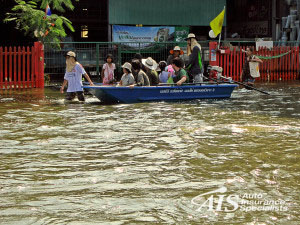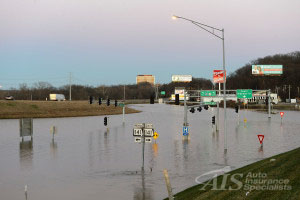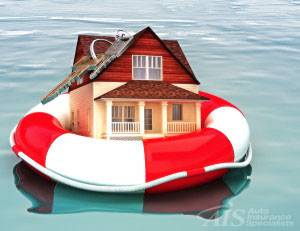After a heavy storm, we’ve all seen images of people rowing a boat down the middle of their flooded street. These scenes keep the focus on immediate safety issues and take our minds off of the terrible damage that floods can cause to Americans’ property and belongings. And after all, if those affected by the flood have homeowners or renters insurance, they’ll eventually get reimbursed for everything they had that was damaged – right?
Wrong.
In reality, standard property insurance policies do not cover every conceivable calamity that can befall the policyholder. And one of the most common exclusions in these policies is flooding caused by natural events.
Is That Water Damage Covered?
It’s true that homeowners and renters insurance does cover certain types of water damage, such as burst pipes, broken washing machine hoses, or ruptured water heaters. But the source of the damage has to be “sudden and accidental” in order for it to fall under the purview of residential property policies.
However, standard renters and homeowners insurance will not cover flooding caused by events like:
- Severe thunderstorms

- Hurricanes
- Snowmelt or icemelt
- Overflowing rivers, lakes, streams, or ponds
Most Americans Are In Danger of Being Wiped Out By a Flood
The Federal Emergency Management Agency reports that flooding costs Americans billions of dollars in damages each year. Hurricane Katrina in 2005 resulted in insurance claim payments totaling a mind-boggling $16.2 billion.
Here’s the sad part: each year, many people discover that their flood-damaged possessions and property are not covered by insurance. The Insurance Information Institute estimates that only about one out of every ten businesses and homeowners has any type of flood insurance policy. For those who aren’t covered, they may be forced to either go out of business, declare bankruptcy, or lose their life’s savings trying to replace the assets they’ve lost.
Purchasing the Right Flood Insurance
Now that we’ve identified the importance of flood insurance, the next question is: how do you go about obtaining coverage?
In some ways, it’s the same as acquiring any other type of insurance. You just contact an insurance broker, agent, or company which provides flood insurance and then enroll in a policy. But the main difference is that flood insurance is subsidized by the federal government.
The National Flood Insurance Program was created by Congress in 1968 in order to reduce the economic burdens caused by damages and losses to homes and businesses due to flooding. Most American communities, especially those which are prone to flooding, have joined the NFIP. Insurers who write flood insurance under the program are required to remain in compliance with the NFIP’s rules and regulations if they want their customers to receive government-subsidized coverage.
There’s one very important aspect of flood insurance that you need to know. All policies written under the NFIP are subject to a 30-day waiting period from the time the policy is signed until the coverage takes effect. This means that homeowners or renters cannot wait until they see an impending storm or similar event approaching and expect to be covered by flood insurance before the inclement weather strikes.
How Flood Insurance Works
As with other types of insurance, flood insurance is written with policy limits and deductibles. A typical NFIP flood insurance policy comes with $250,000 worth of coverage to the home, condo, or other dwelling type, along with another $100,000 for the contents of the home. A typical deductible for this policy is $500, though structures that were built prior to 1978 may require deductibles of $1,000.
Of course, you can feel free to alter these limits according to the value of your home and/or its contents. For example, if your house, condo, or apartment contains numerous valuable items, $100,000 might not be enough to reimburse you for severe flood damages. On the other hand, you can elect to purchase flood insurance for only your home’s structure or its contents if you don’t feel that you need both.

How Risky Is Your Home To Insure Against Flooding?
In addition to the home and its contents, another vital factor in determining flood insurance rates is the location of the structure – more specifically, its position relative to flood-prone areas.
Insurance providers who write insurance through the NFIP utilize three categories of risk regarding the location of a property: low, moderate, or high. People who live in a home in a low to moderate risk area can qualify for what is known as a preferred risk policy.
According to the NFIP site, there are basic annual rates for various levels of flood insurance coverage for preferred risk policyholders. A policy with $250,000 worth of coverage for the building and $100,000 for its contents runs about $405 per year for a home without a basement and $452 annually for a dwelling with a basement. That works out to about $33.75 a month and $37.67 a month, respectively. Policies with lower coverage amounts and/or coverage for only the home’s contents are less costly.
However, the flood insurance pricing process is a bit more complex for homes which are located in a high-risk area. These homeowners or renters are only eligible for what is called a standard rated policy. What’s more, if you purchase a home in a high-risk area using a mortgage issued by a federally insured or regulated lender, you are required by law to buy a flood insurance policy as well.
Standard rated policies must be obtained using FEMA’s General Property form (which can be found here). The annual premiums for these dwellings are based on several factors, including:
- Number of floors
- Building occupancy
- Year of construction
- Location of its contents
- Location of the lowest floor relative to the flood map elevation requirement
If you want to figure out what risk category your home falls into for flood insurance, you can search for the relevant flood map for your address on the FEMA site here.
AIS Sells Flood Insurance
If you think that all of this information about flood insurance is a bit confusing, then it’s perfectly okay to ask for a little help. The experienced individuals at AIS Insurance can answer any questions you might have about flood insurance, and can also find an NFIP-backed policy for your home at an affordable price. So if you want the peace of mind that comes with being adequately insured against all types of flood-causing natural disasters, contact an AIS representative today!
The information in this article was obtained from various sources. This content is offered for educational purposes only and does not represent contractual agreements, nor is it intended to replace manuals or instructions provided by the manufacturer or the advice of a qualified professional. The definitions, terms and coverage in a given policy may be different than those suggested here and such policy will be governed by the language contained therein. No warranty or appropriateness for a specific purpose is expressed or implied.

